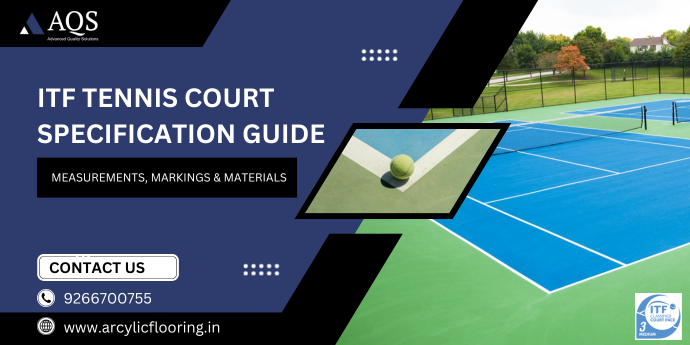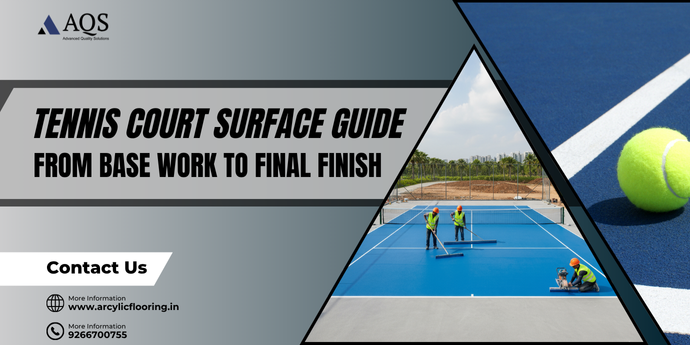In India, building a tennis court has always been a dream with high costs and complex infrastructure. But with synthetic acrylic tennis court flooring and local manufacturing, that is high in demand. Today, individuals and institutions are realising that a professional tennis court doesn’t have to be a luxury. It can be a smart and affordable investment that adds huge value to communities, schools, academies and residential complexes.
As one of the leading tennis court construction companies in India. AQS offers complete solutions from asphalt tennis court construction to synthetic surface installation. Which helps clients to build durable courts that meet international play standards while keeping overall tennis court construction costs low and transparent.
This guide will show you how to build a low-cost tennis court flooring, covering materials, base types, construction process and real estimates cost.
Tennis Court Construction Process
Tennis court construction is an engineering process with several important stages that contribute to the court’s final quality, safety and cost efficiency. From the foundation to the final paint line, every detail matters.
1. Site Preparation and Base Work
The base is the structural foundation of every tennis court, determining surface durability and drainage efficiency. Proper grading, compaction and moisture control is important before any coating application begins.
- Asphalt Base – Preferred for its flexibility, smoothness and ability to handle India’s weather. It allows water drainage, stops surface cracks and moisture bubbles.
- Concrete Base (RCC) – Ideal for permanent, high traffic tennis courts. It provides excellent load bearing strength and stability but requires expansion joints to stops cracking.
AQS recommends asphalt tennis court construction for most projects looking for balance between performance, cost and long term investment. Asphalt surfaces adapt to minor ground movements, maintain an even slope and enhance coating fixing for a perfect finish.
2. Layering and Surface Coating
Once the base is constructed and cured, the next step is to apply multiple layers of synthetic acrylic coatings that define texture, grip and bounce consistency. Each coating layer serves a unique purpose in achieving professional level play.
- Concrete/Asphalt Primer – Acts as a bonding bridge between the base and acrylic system, seals pores and makes sure superior fixing.
- Acrylic Resurfacer with Silica Sand – Creates a uniform, textured surface that masks minor imperfections and enhances durability against wearing.
- Cushion Coats – Cushioned systems to provide shock absorption and comfort, reduces stress on players’ joints during long matches.
- Color Coats – Used vibrant color and surface protection with UV resistant pigments that stops fading and peeling under harsh sun.
- Line Marking – Applied precisely for fair game, using high contrast, anti-slip acrylic paint for clear visibility and tournament compliance.
Every layer is formulated to improve court life, elasticity, UV resistance and bounce uniformity, for smooth play and long term surface integrity.
3. Finishing and Accessories
The final stage turns the coated surface into a complete professional tennis court ready for use. Proper finishing enhances play quality, safety and aesthetics and makes sure the court meets international standards. Net Posts and Center Strap Installed with precise alignment to maintain net height and tension across the tennis court.
- Fencing – Protects viewers and defines boundaries while allows air to flow around the court.
- Court Lighting – For evening or indoor play, evenly illuminates the surface without glare or shadows.
- Drainage and Pathway Setup – Quick water runoff and player access, reduces downtime during rainy conditions.
All these finishing elements make up the AQS tennis court, performance, safety and professional design in one.
Choosing the Right Tennis Court Flooring Material
Choosing the right tennis court material is the most important decision to achieve high performance and cost effectiveness. Among all the options clay, grass, PU, and synthetic acrylic flooring is the most durable, affordable and low maintenance for long term playability.
Why Synthetic Acrylic Flooring Wins?
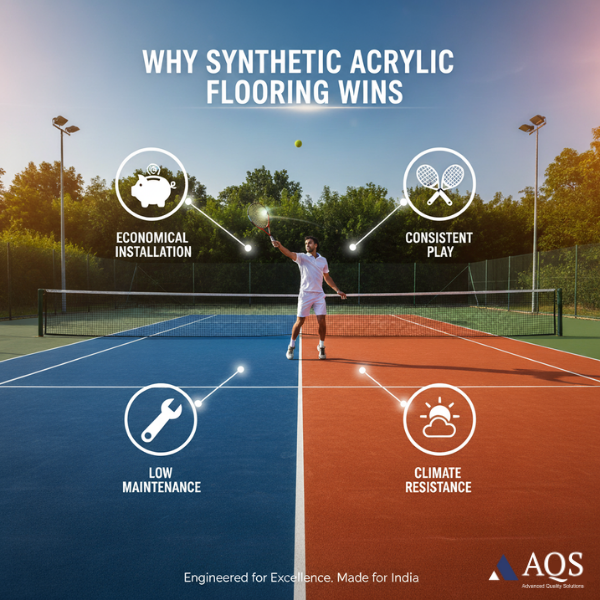
Economical Installation: Acrylic systems require no imported or special raw materials, overall project cost is reduced. They use locally available components that deliver world class performance without costly budget.
Low Maintenance: Once installed synthetic acrylic tennis courts are easy to maintain with minimal effort only requires monthly cleaning and fresh color coat every 5-6 years. This makes sure years of professional play with low maintenance cost.
Consistent Play: Engineered for precision, acrylic surfaces provide uniform bounce, balanced traction and medium pace ideal for practice sessions, competitive matches and professional tournaments.
Climate Resistance: Acrylic coatings are designed to withstand Indian climate intense UV radiation, heavy rainfall and temperature variations without fading or cracking.
AQS’s synthetic tennis court material is cost effective and engineered. It performs equally well on asphalt and concrete bases hence is a reliable solution for tennis court construction in all regions from humid coastal states to aired zones of northern India.
Comparing Tennis Court Surface Materials
| Surface Type | Average Cost (₹/sq.ft) | Maintenance Level | Lifespan | Remarks |
| Clay Court | ₹180–₹250 | High | 4–5 years | Traditional but needs daily care |
| Grass Court | ₹250–₹400 | Very High | 3–4 years | Expensive and seasonal |
| PU Court | ₹300–₹450 | Medium | 6–8 years | Soft but costly installation |
| Synthetic Acrylic Court | ₹180–₹280 | Low | 8–10 years | Best for cost, durability, and play quality |
Tennis Court Construction Cost Factors
1. Base
The base you choose affects both cost and life. Concrete bases are stronger and longer lasting but costlier, while asphalt bases are flexible, quick to install and affordable perfect for India’s different climate.
2. Layer System
Layering system of a tennis court determines its comfort and playability. Cushioned acrylic systems with 8–9 layers provide better shock absorption and player comfort but add 25–30% to the total project cost compared to non-cushioned, hard-court options.
3. Location & Transportation
Cost also depends on logistics and material availability. Courts near tennis court builders or local manufacturers like AQS have lower transportation cost and faster delivery time, hence better value for money.
4. Add-Ons
Optional features like lighting poles, fencing, seating zones and custom line markings enhance the overall look and functionality of the tennis court. Including these in the initial planning phase avoids rework and minimizes additional labor or material cost.
Why Asphalt Tennis Court Is Best Value For Money?
Asphalt tennis courts have become the go to choice for builders and institutions looking for an affordable yet professional grade surface. The combination of smoothness, flexibility and compatibility with synthetic acrylic coatings makes asphalt a proven base for long lasting tennis court flooring.
Benefits:
- Smooth and Flexible Surface: Asphalt provides a smooth, even surface that minimizes surface irregularities and allows slight flexibility to reduce cracking due to thermal expansion or ground movement.
- Cost Effective Base Layer: Unlike reinforced concrete (RCC), asphalt requires less material and labor, making it a budget friendly option that still delivers great performance and strength.
- Faster Installation: Asphalt courts can be laid and cured faster than concrete bases, so projects can be completed faster and less downtime for academies and housing projects.
- Foundation for Acrylic Coatings: Tennis hard court material its porous structure allows strong fixing of synthetic acrylic layers, creating a durable and resilient surface that meets international play standards.
AQS uses high grade bitumen and mineral aggregates designed for sports applications, so the surface is stable and performs well for long term. Each court is built with precise slope and vapor barrier system to prevent water seepage a common problem in low cost courts built without expert supervision.
Synthetic Acrylic Tennis Court Flooring
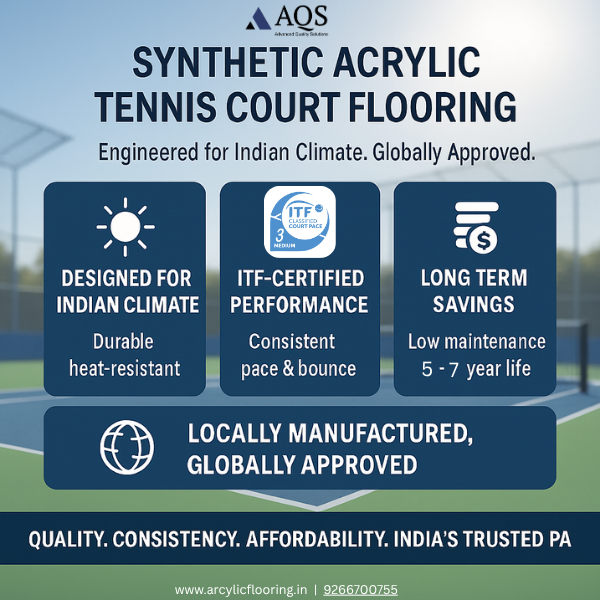
Designed for Indian Climate
AQS acrylic systems are UV-stable, heat-resistant, and moisture-tolerant to perform in India’s extreme temperatures, humidity and rainfall. So the surface remains crack-free, color-stable and playable throughout the year, from coastal humidity to dry northern plains.
ITF-Certified Performance
Each AQS tennis court system meets ITF pace classification standards for consistent ball speed and bounce. Players get consistent friction and surface response like international tournament conditions, ideal for schools, clubs and academies.
Complete Material System
AQS offers scientifically balanced system covering every layer from Concrete Primer to Color Coats engineered for adhesion, elasticity and playability. Each product is designed to bond seamlessly, ensuring durability and professional finish across all court types.
- Acrylic Resurfacer with Silica Sand for Texture
This base layer creates uniform roughness and strengthens the coating bond, provides perfect traction and grip for players. It enhances surface texture and prevents early wear, ensures consistent bounce quality across the court.
- Cushion Coats for Shock Absorption
Formulated with acrylic and rubber granules, these layers reduce joint impact and improve player comfort during long matches. The cushioning system gives a softer feel underfoot without compromising speed or surface consistency.
- Color Coats for Grip and Aesthetics
High quality pigmented acrylic color coats provide vibrant, UV-resistant finishes and skid resistance. Available in multiple shades, they offer both aesthetic appeal and functional traction for control.
- Line Marking Paint for Precision
Bright, non-fading acrylic line paints for crisp and accurate markings that stay visible even under heavy play. The coating’s high reflectivity helps players and referees to see clearly during matches.
Long Term Savings
AQS surfaces are designed for durability, so you don’t need to recoat or maintain frequently. With minimal maintenance, you save big over the court’s 10-15 year life, that’s true cost savings.
Locally Manufactured, Globally Approved
All AQS materials are manufactured in India under globally tested and certified formulations. So you get competitive pricing, faster delivery and international quality without importing components.
Tennis Court Builders and Construction Companies
Choosing the right tennis court construction company decides how your court looks today and how it will perform for the next 10 years. AQS partners with verified tennis court builders across India to ensure every project meets ITF standards and local engineering norms.
What to Look For:
- Experience in Synthetic Tennis Court Flooring: Choose contractors who have experience in designing and laying synthetic acrylic tennis court flooring, so the bounce, texture and performance is consistent.
- Use of AQS Certified Materials: Always choose builders who use ITF approved, AQS certified materials, so the court is long lasting, UV resistant and has pace classification suitable for all levels of play.
- Trained Installation Teams: A trained team ensures the slope, layer thickness and curing is done correctly so that the court surface doesn’t crack, delaminate or wear out prematurely.
- References from Schools, Clubs or Government Projects: Reviewing completed projects helps you assess the real world performance and craftsmanship, so you can trust the builder’s credibility and adherence to quality standards.
AQS’s network of certified tennis court builders makes it easy for clients searching “tennis court installation near me.” From material supply to on site technical support, AQS ensures hassle free and high quality installations across India.
Green and Smart Construction
AQS builds not only durable courts but also green sports infrastructure. Every project focuses on eco-friendly materials, efficient design and minimal environmental impact as per India’s evolving green building standards.
- Water Based Acrylics:
AQS uses water based, low-VOC acrylics that emit less pollutants, for healthier playing conditions for players, workers and environment. - Local Sourcing: Reduced Transport Emissions:
By manufacturing and sourcing materials locally, AQS reduces transportation distance, significantly reducing carbon emissions and project cost. - Recyclable Packaging: Responsible Material Handling:
Packaging materials are recyclable, helping builders to manage waste effectively and practice sustainable construction across sites. - Drainage Design: Prevents Erosion and Reduces Maintenance:
Smart slope and drainage design prevents water logging, protects sub-bases and extends the life of the tennis court surface reducing long term maintenance cost.
Through these green strategies AQS ensures every tennis court is high performance and eco friendly, built to last and built to care.
Why Choose AQS for Low-Cost Tennis Court Construction?
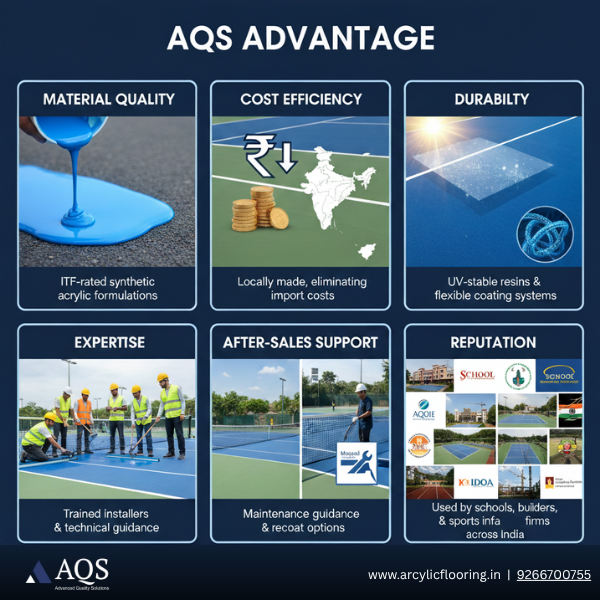
| Feature | AQS Advantage |
| Material Quality | ITF-rated synthetic acrylic formulations |
| Cost Efficiency | Locally made, eliminating import costs |
| Durability | UV-stable resins and flexible coating systems |
| Expertise | Trained installers and technical guidance |
| After-Sales Support | Maintenance guidance and recoat options |
| Reputation | Used by schools, builders, and sports infra firms across India |
When quality, consistency, and affordability matter AQS stands as India’s trusted tennis court flooring partner.
Common Mistakes to Avoid in Budget Tennis Court Construction
- No Moisture Barrier: Not having a vapor or moisture barrier means water can rise through the slab and cause bubbles, delamination and surface failure over time. Always seal the base before applying acrylic layers.
- Poor Slope: Not planning the slope properly means water doesn’t drain efficiently and you get puddles, algae and long term damage to the coatings. AQS recommends a 1:100 slope ratio for uniform runoff.
- Cheap Paint Instead of Acrylic: Using regular exterior paint instead of synthetic acrylic tennis court material may seem cheap at first but will fade, crack and wear out in months. ITF rated coatings ensure longevity and bounce consistency.
- Not Compacting Subgrade: Not compacting the subgrade before base construction means the surface will settle unevenly and crack. AQS insists on strict compaction standards for long term court stability
- Untrained Labour: Unskilled labourers apply uneven layers or wrong material ratios and you get inconsistent ball bounce and poor finish. Always use AQS trained installation teams for precision layering and professional results.
Working with AQS approved tennis court builders eliminates these costly mistakes and even a budget court will perform like a top tier court.
Conclusion:
Building a tennis court in India doesn’t need to break the bank or import materials. The evolution of synthetic tennis court flooring especially acrylic based systems has made it possible for institutions and individuals to have international standard courts at local prices. The key is not in cutting corners but in choosing the right materials, certified tennis court builders and proven engineering processes.
AQS is at the heart of this evolution. With our tennis hard court materials, advanced acrylic coatings and end to end installation expertise AQS redefines what affordable sports infrastructure can look like. Each AQS court is not just built it’s engineered for performance, so you get perfect grip, pace and resilience season after season.
In an era where sports infrastructure defines community engagement and wellness AQS enables India to play, train and grow on surfaces built to last and priced for accessibility.
Frequently Asked Questions
Synthetic acrylic flooring is the most affordable and durable.
Yes, asphalt offers flexibility and faster installation at lower cost.
ITF-rated synthetic acrylic material is used for consistent performance.
With proper maintenance, it lasts 5–7 years.
Yes, AQS systems are ideal for residential and community projects.
Primer, resurfacer, cushion coats, color coats, and line markings.

